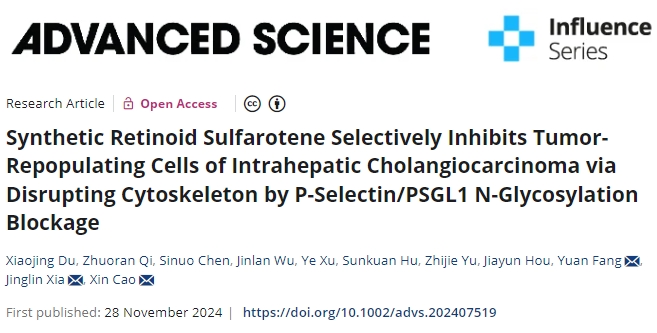预约演示
更新于:2025-05-07
MGAT2
更新于:2025-05-07
基本信息
别名 alpha-1,6-mannosyl-glycoprotein 2-beta-N-acetylglucosaminyltransferase、Beta-1,2-N-acetylglucosaminyltransferase II、GlcNAc-T II + [4] |
简介 Plays an essential role in protein N-glycosylation. Catalyzes the transfer of N-acetylglucosamine (GlcNAc) onto the free terminal mannose moiety in the core structure of the nascent N-linked glycan chain, giving rise to the second branch in complex glycans. |
关联
5
项与 MGAT2 相关的药物作用机制 MGAT2抑制剂 [+1] |
在研机构 |
在研适应症 |
非在研适应症- |
最高研发阶段临床2期 |
首次获批国家/地区- |
首次获批日期1800-01-20 |
靶点 |
作用机制 MGAT2抑制剂 |
在研适应症 |
非在研适应症- |
最高研发阶段临床前 |
首次获批国家/地区- |
首次获批日期1800-01-20 |
靶点 |
作用机制 MGAT2抑制剂 |
在研适应症 |
非在研适应症 |
最高研发阶段临床前 |
首次获批国家/地区- |
首次获批日期1800-01-20 |
8
项与 MGAT2 相关的临床试验NCT06106334
A Crossover, Phase 1, Open-label, One-arm Study to Investigate the Effect of Itraconazole on the Pharmacokinetics of S-309309 in Healthy Male and Female Participants
The primary purpose of this study is to determine the effect of repeated administration of itraconazole on the pharmacokinetic (PK) profile of S-309309; and the PK of S-309309 following administration of S-309309 alone and co-administration with itraconazole
开始日期2023-11-15 |
申办/合作机构 |
NCT05925114
A Phase 2, Multicenter, Randomized, Double-blind, Dose-ranging, Placebo-controlled Study to Assess the Safety and Efficacy of S-309309 in Obese Adults
The primary objective of this study is to understand the efficacy of S-309309 on the body weight of obese adults.
开始日期2023-06-21 |
申办/合作机构 |
NCT05247970
A Phase 1 Randomized, Double-blind, Single and Multiple-dose Study to Assess the Safety, Tolerability, Pharmacokinetics, Food Effect, and Drug-Drug Interactions of S-309309 in Healthy and Obese Adult Study Participants
The primary aim of the study is to assess the safety and tolerability of S-309309 after oral administration in healthy adult or obese but otherwise healthy adult participants. The secondary aim of the study is to assess the pharmacokinetics of S-309309 and the effects on ECG parameters after oral administration in healthy or obese but otherwise healthy participants.
开始日期2022-01-04 |
申办/合作机构 |
100 项与 MGAT2 相关的临床结果
登录后查看更多信息
100 项与 MGAT2 相关的转化医学
登录后查看更多信息
0 项与 MGAT2 相关的专利(医药)
登录后查看更多信息
158
项与 MGAT2 相关的文献(医药)2025-03-01·Brain Research
Exploring the relationship between MGAT2 and glioblastoma: A Mendelian Randomization and bioinformatics approach
Article
作者: Gao, Shangfeng ; Xiao, Weihan ; Qiu, Zili ; Cheng, Hai ; Yin, Luxin ; Liu, Xuejiao ; Guo, Chengcheng
2024-11-01·Biochemical and Biophysical Research Communications
Subcellular imaging of MGAT1/MGAT2 homo- and heteromers in living cells using bioluminescence microscopy
Article
作者: Olczak, Mariusz ; Wiertelak, Wojciech ; Maszczak-Seneczko, Dorota
2024-07-01·Journal of Inherited Metabolic Disease
Deficient glycan extension and endoplasmic reticulum stresses in ALG3‐CDG
Article
作者: Freeze, Hudson H ; Alsharhan, Hind ; Edmondson, Andrew C ; Daniel, Earnest J P ; Argon, Yair ; Lam, Christina ; He, Miao
4
项与 MGAT2 相关的新闻(医药)2024-12-01
11月28日,复旦大学研究团队在期刊《Advanced Science》上发表了题为“Synthetic Retinoid Sulfarotene Selectively Inhibits Tumor-Repopulating Cells of Intrahepatic Cholangiocarcinoma via Disrupting Cytoskeleton by P-Selectin/PSGL1 N-Glycosylation Blockage”的研究论文,本研究中,研究人员发现尽管5-氟尿嘧啶、顺铂、佩米加汀和吉西他滨都能抑制ICC-TRCs,但硫福罗汀的效能更为显著。硫福罗汀能将视黄醇受体α(RARɑ)从细胞质转运至细胞核,并通过转录水平抑制P-选择素的表达。此外,它还能直接与FUT8相互作用。这些作用共同作用,通过破坏PSGL1-调控的细胞骨架来抑制ICC-TRCs。这些发现为通过破坏P-选择素/PSGL1相互作用和改变PSGL1糖基化模式来破坏细胞骨架完整性和消除ICC-TRCs提供了策略。
11月28日,复旦大学研究团队在期刊《Advanced Science》上发表了题为“Synthetic Retinoid Sulfarotene Selectively Inhibits Tumor-Repopulating Cells of Intrahepatic Cholangiocarcinoma via Disrupting Cytoskeleton by P-Selectin/PSGL1 N-Glycosylation Blockage”的研究论文,本研究中,研究人员发现尽管5-氟尿嘧啶、顺铂、佩米加汀和吉西他滨都能抑制ICC-TRCs,但硫福罗汀的效能更为显著。硫福罗汀能将视黄醇受体α(RARɑ)从细胞质转运至细胞核,并通过转录水平抑制P-选择素的表达。此外,它还能直接与FUT8相互作用。这些作用共同作用,通过破坏PSGL1-调控的细胞骨架来抑制ICC-TRCs。
这些发现为通过破坏P-选择素/PSGL1相互作用和改变PSGL1糖基化模式来破坏细胞骨架完整性和消除ICC-TRCs提供了策略。
https://onlinelibrary.wiley.com/doi/full/10.1002/advs.202407519
https://onlinelibrary.wiley.com/doi/full/10.1002/advs.202407519
背景信息
背景信息
01
01
肝内胆管癌(ICC)在中国和东南亚地区发病率尤其高,是仅次于肝细胞癌的原发性肝癌第二大类型,占肝恶性肿瘤的20%左右,占所有消化系统恶性肿瘤的3%。这是一种高度侵袭性和致命的疾病,5年总体生存率(OS)仍维持在9%左右。仅有20%-30%的患者在可切除阶段被诊断出来,但即使经过手术切除,5年生存率也只有约20%-35%。相比之下,大多数不可切除患者的中位生存期(mOS)为11.7个月。尽管手术和系统性治疗的领域正在迅速发展,但治疗效果仍然不佳。因此,迫切需要探索更有效的ICC治疗方法。
肝内胆管癌(ICC)在中国和东南亚地区发病率尤其高,是仅次于肝细胞癌的原发性肝癌第二大类型,占肝恶性肿瘤的20%左右,占所有消化系统恶性肿瘤的3%。这是一种高度侵袭性和致命的疾病,5年总体生存率(OS)仍维持在9%左右。仅有20%-30%的患者在可切除阶段被诊断出来,但即使经过手术切除,5年生存率也只有约20%-35%。相比之下,大多数不可切除患者的中位生存期(mOS)为11.7个月。尽管手术和系统性治疗的领域正在迅速发展,但治疗效果仍然不佳。因此,迫切需要探索更有效的ICC治疗方法。
肿瘤再生细胞(TRCs)代表了一群自我更新能力强、高度肿瘤形成的癌细胞亚群,在癌症的关键事件中发挥着关键作用。这些事件包括维持细胞增殖、抵抗细胞死亡、远距离转移、免疫逃避、代谢重编程、衰老相关分泌表型以及耐药性等。为了消除这些TRCs,本研究小组开发了一种新型合成维甲酸,称为硫福罗汀(WYC-209,SFT)。在体外和体内评估,包括患者来源的异种移植(PDX)模型中,SFT对各种癌症类型的TRCs显示出卓越的抑制作用,因此它被用作潜在的TRCs靶向分子。SFT对TRCs的选择性抑制可能有助于解决上述ICC问题。
肿瘤再生细胞(TRCs)代表了一群自我更新能力强、高度肿瘤形成的癌细胞亚群,在癌症的关键事件中发挥着关键作用。这些事件包括维持细胞增殖、抵抗细胞死亡、远距离转移、免疫逃避、代谢重编程、衰老相关分泌表型以及耐药性等。为了消除这些TRCs,本研究小组开发了一种新型合成维甲酸,称为硫福罗汀(WYC-209,SFT)。在体外和体内评估,包括患者来源的异种移植(PDX)模型中,SFT对各种癌症类型的TRCs显示出卓越的抑制作用,因此它被用作潜在的TRCs靶向分子。SFT对TRCs的选择性抑制可能有助于解决上述ICC问题。
FUT8是ICC-TRCs中SFT的直接靶点
FUT8是ICC-TRCs中SFT的直接靶点
02
02
糖基化是在细胞内质网/高尔基体中的一种酶促过程,是蛋白质翻译后修饰的主要方式之一,由不同的糖基转移酶和/或糖苷酶催化。鉴于SFT对RARɑ的影响,研究人员首先推测它可能通过增加核内RARɑ的转运来调节糖基转移酶/糖苷酶的转录。经过交集运算后,研究人员重点关注了MGAT3基因,它是N-乙酰葡萄糖胺转移酶III的编码基因,通过β1,4糖苷键将N-乙酰葡萄糖胺连接到β-岩藻糖上,从而催化N-糖链核心的三糖N-甘露糖的β1,4糖苷键的形成。RNA-seq和qRT-PCR数据表明,SFT处理显著降低了ICC-TRCs中MGAT3 mRNA的水平,但在2D ICC细胞中未见明显变化。因此,研究人员使用siRNA沉默ICC-TRCs中的MGAT3。然而,沉默MGAT3未能抑制PSGL1的糖基化、细胞球体的生长、迁移和侵袭。这些结果表明,MGAT3的变化只是SFT治疗后的附加效应,而不是SFT抑制ICC-TRCs的原因。
糖基化是在细胞内质网/高尔基体中的一种酶促过程,是蛋白质翻译后修饰的主要方式之一,由不同的糖基转移酶和/或糖苷酶催化。鉴于SFT对RARɑ的影响,研究人员首先推测它可能通过增加核内RARɑ的转运来调节糖基转移酶/糖苷酶的转录。经过交集运算后,研究人员重点关注了MGAT3基因,它是N-乙酰葡萄糖胺转移酶III的编码基因,通过β1,4糖苷键将N-乙酰葡萄糖胺连接到β-岩藻糖上,从而催化N-糖链核心的三糖N-甘露糖的β1,4糖苷键的形成。RNA-seq和qRT-PCR数据表明,SFT处理显著降低了ICC-TRCs中MGAT3 mRNA的水平,但在2D ICC细胞中未见明显变化。因此,研究人员使用siRNA沉默ICC-TRCs中的MGAT3。然而,沉默MGAT3未能抑制PSGL1的糖基化、细胞球体的生长、迁移和侵袭。这些结果表明,MGAT3的变化只是SFT治疗后的附加效应,而不是SFT抑制ICC-TRCs的原因。
研究人员从HUCCT1-TRCs中提取总蛋白,并用DMSO或SFT(1 mm)处理。经胰蛋白酶消化后,使用质谱进行分析。生物信息学分析确定这些4047个肽段代表了1791种不同的蛋白质。随后,使用数据库将蛋白质转换为对应的编码基因。将它们与糖基转移酶或糖苷酶编码基因进行交集,总共获得了10个潜在的直接靶点,包括OGT、MGAT2、GALNT2、GALNT6、GALNT7、PIGT、FUT8、POFUT1、ALG2和UGGT1。RNA-seq数据表明,SFT治疗后这些基因的表达没有显著变化。研究人员推测,SFT可能通过直接与它们结合来调节酶的活性。
研究人员从HUCCT1-TRCs中提取总蛋白,并用DMSO或SFT(1 mm)处理。经胰蛋白酶消化后,使用质谱进行分析。生物信息学分析确定这些4047个肽段代表了1791种不同的蛋白质。随后,使用数据库将蛋白质转换为对应的编码基因。将它们与糖基转移酶或糖苷酶编码基因进行交集,总共获得了10个潜在的直接靶点,包括OGT、MGAT2、GALNT2、GALNT6、GALNT7、PIGT、FUT8、POFUT1、ALG2和UGGT1。RNA-seq数据表明,SFT治疗后这些基因的表达没有显著变化。研究人员推测,SFT可能通过直接与它们结合来调节酶的活性。
硫福罗汀直接与FUT8结合
硫福罗汀直接与FUT8结合
为了确定直接靶点,研究人员评估了ICC中10个潜在靶点的重要性。差异分析显示,OGT、GALNT2、GALNT6、GALNT7、PIGT、FUT8、POFUT1、ALG2和UGGT1在ICC组织中的表达水平高于正常组织。生存分析显示,只有FUT8与患者的总生存期(OS)和无复发生存期(RFS)显著相关。SFT治疗不会对FUT8的mRNA或蛋白水平产生显著影响。研究人员通过将这10个残基替换为ALA构建了突变型FUT8,并纯化了FUT8WT和FUT8MT蛋白。MST数据表明,SFT与FUT8WT蛋白具有很强的亲和力,但与FUT8MT蛋白的亲和力降低,Kd值分别为9.83E-08和2.83E-07。模拟对接数据表明,SFT与SER245、ASN247、GLY253、THR267形成稳定的氢键相互作用,与ILE242、TRP255、PRO261形成疏水相互作用。因此,SFT可能直接与ICC-TRC中的FUT8结合。
为了确定直接靶点,研究人员评估了ICC中10个潜在靶点的重要性。差异分析显示,OGT、GALNT2、GALNT6、GALNT7、PIGT、FUT8、POFUT1、ALG2和UGGT1在ICC组织中的表达水平高于正常组织。生存分析显示,只有FUT8与患者的总生存期(OS)和无复发生存期(RFS)显著相关。SFT治疗不会对FUT8的mRNA或蛋白水平产生显著影响。研究人员通过将这10个残基替换为ALA构建了突变型FUT8,并纯化了FUT8WT和FUT8MT蛋白。MST数据表明,SFT与FUT8WT蛋白具有很强的亲和力,但与FUT8MT蛋白的亲和力降低,Kd值分别为9.83E-08和2.83E-07。模拟对接数据表明,SFT与SER245、ASN247、GLY253、THR267形成稳定的氢键相互作用,与ILE242、TRP255、PRO261形成疏水相互作用。因此,SFT可能直接与ICC-TRC中的FUT8结合。
为了研究FUT8在ICC-TRCs中的作用,研究人员使用特异性的sgRNAs在HUCCT1-TRCs中敲低FUT8。FUT8的缺失显著抑制了HUCCT1-TRCs的克隆球体形成、迁移和侵袭,降低了F-肌动蛋白荧光强度和F/G-肌动蛋白比率,并降低了HUCCT1-TRCs中糖基化的PSGL1蛋白的表达。此外,研究人员将空载体、FUT8WT或FUT8MT质粒转染到FUT8敲除的HUCCT1-TRCs中。研究人员发现,SFT治疗只能将PSGL1从约70 kDa降至约35 kDa,而在FUT8敲除的HUCCT1-TRCs或FUT8MT HUCCT1-TRCs中,效果不明显。此外,SFT治疗在FUT8WT HUCCT1-TRCs中产生了最强的抑制作用,包括克隆球体形成、迁移和侵袭,以及F/G-肌动蛋白比率,而在FUT8KO HUCCT1-TRCs或FUT8MT HUCCT1-TRCs中产生了较弱的抑制作用。综上所述,抑制FUT8的活性是SFT抑制ICC-TRCs的另一种机制。
为了研究FUT8在ICC-TRCs中的作用,研究人员使用特异性的sgRNAs在HUCCT1-TRCs中敲低FUT8。FUT8的缺失显著抑制了HUCCT1-TRCs的克隆球体形成、迁移和侵袭,降低了F-肌动蛋白荧光强度和F/G-肌动蛋白比率,并降低了HUCCT1-TRCs中糖基化的PSGL1蛋白的表达。此外,研究人员将空载体、FUT8WT或FUT8MT质粒转染到FUT8敲除的HUCCT1-TRCs中。研究人员发现,SFT治疗只能将PSGL1从约70 kDa降至约35 kDa,而在FUT8敲除的HUCCT1-TRCs或FUT8MT HUCCT1-TRCs中,效果不明显。此外,SFT治疗在FUT8WT HUCCT1-TRCs中产生了最强的抑制作用,包括克隆球体形成、迁移和侵袭,以及F/G-肌动蛋白比率,而在FUT8KO HUCCT1-TRCs或FUT8MT HUCCT1-TRCs中产生了较弱的抑制作用。综上所述,抑制FUT8的活性是SFT抑制ICC-TRCs的另一种机制。
结语
结语
03
03
本研究揭示了P-选择素/PSGL1轴在ICC中通过重塑细胞骨架促进干细胞特性的新作用。研究人员还发现了硫福罗汀选择性抑制ICC-TRCs的新机制。这些发现扩大了硫福罗汀在癌症治疗中的潜在应用。(转化医学网360zhyx.com)
本研究揭示了P-选择素/PSGL1轴在ICC中通过重塑细胞骨架促进干细胞特性的新作用。研究人员还发现了硫福罗汀选择性抑制ICC-TRCs的新机制。这些发现扩大了硫福罗汀在癌症治疗中的潜在应用。(转化医学网360zhyx.com)
【参考资料】
【参考资料】
https://onlinelibrary.wiley.com/doi/full/10.1002/advs.202407519
https://onlinelibrary.wiley.com/doi/full/10.1002/advs.202407519
【关于投稿】
【关于投稿】
转化医学网(360zhyx.com)是转化医学核心门户,旨在推动基础研究、临床诊疗和产业的发展,核心内容涵盖组学、检验、免疫、肿瘤、心血管、糖尿病等。如您有最新的研究内容发表,欢迎联系我们进行免费报道(公众号菜单栏-在线客服联系),我们的理念:内容创造价值,转化铸就未来!
转化医学网(360zhyx.com)是转化医学核心门户,旨在推动基础研究、临床诊疗和产业的发展,核心内容涵盖组学、检验、免疫、肿瘤、心血管、糖尿病等。如您有最新的研究内容发表,欢迎联系我们进行免费报道(公众号菜单栏-在线客服联系),我们的理念:内容创造价值,转化铸就未来!
转化医学网(360zhyx.com)发布的文章旨在介绍前沿医学研究进展,不能作为治疗方案使用;如需获得健康指导,请至正规医院就诊。
转化医学网(360zhyx.com)发布的文章旨在介绍前沿医学研究进展,不能作为治疗方案使用;如需获得健康指导,请至正规医院就诊。

临床结果临床研究
2024-07-12
深度聚焦多肽、多肽偶联药物研发、质控、工艺开发,展位咨询&免费入场券:联系电话181 1603 6798,扫码立即获取免费入场券:
1、诺和诺德Wegovy(司美格鲁肽)和礼来Mounjaro(替西帕肽)引爆降糖减肥市场
2021年中诺和诺德推出Wegovy(司美格鲁肽)后,引起了市场的剧烈轰动,公众和名人的竞相追求,导致药物供不应求和社交媒体风暴,一时“洛阳纸贵”。
图例:钢铁侠马斯克使用司美格鲁肽后减重效果明显
不过,后起之秀礼来的糖尿病药物Mounjaro(替西帕肽)有望在减肥领域超越司美格鲁肽,于4月发布的数据显示该药物的最新III期减重数据优异,。
图例:替西帕肽III期减重数据明显
据测算,司美格鲁肽和替西帕肽这两种药物将每年创造数十亿美元的销售额。虽然创新药的研发失败率远高于成功率,但巨大的市场想象空间仍使一众药企对该领域药物的开发充满热情。
司美格鲁泰和替西帕肽最初设计的适应症均是用于临床降糖药物,而减肥的适应症是“预料之外”的适应症拓展。司美格鲁泰是GLP-1类似物,可以和GLP-1受体结合,激活下游通路从而起到降糖减重的作用。
替西帕肽是GLP-1/GIP双通道激动剂,激活GLP-1受体和葡萄糖依赖性胰岛素促泌多肽(GIP)的肠道激素。通过同时作用于GLP-1和GIP这两个通道,替西帕肽可能比仅使用GLP-1激动剂的减重效果更优。
胰高血糖素样肽-1,英文全称Glucagon-like Peptide-1,简称:GLP-1。是一种由肠道内分泌L细胞和脑干孤束核内的某些神经元在进食后产生和分泌的活性肽类激素。其通过结合GLP-1受体(GLP-1R),激活受体的信号传导,起到增加胰岛素分泌、抑制胰高血糖素分泌、减缓胃肠道蠕动、抑制食欲等的生物学功能,从而可以降低体内血糖水平和食欲,有助于控制体重和血糖。在临床上,GLP-1类似药物已经被广泛地用于2型糖尿病和肥胖的治疗。
Uncle in town,公众号:胖猫的生命医学札记GLP-1药物延长半衰期技术(上)
图例:司美格鲁肽(上)和替西帕肽(下)
在替西帕肽为期72周的SURMOUNT-1肥胖试验中,接受最高剂量的替西帕肽患者平均减重比接受安慰剂的患者多出17.8%。对应的,在司美格鲁肽这边,与安慰剂相比,司美格鲁肽试验参与者的体重减轻了12.4%。
不过由于缺乏头对头临床试验,直接对两者的效果进行比较是不合理的。一些分析师预测,替西帕肽在肥胖症的销售巅峰时期将超过100亿美元,而司美格鲁肽约为80亿美元。
2、下一代的GLP-1在哪里?——改进和升级
然而,GLP-1激动剂并不是适合每一个肥胖症患者。哈佛医学院的肥胖医学专家Fatima Cody Stanford表示,尽管该类药物的长期安全性数据令人放心,但一些患者对这些药物没有反应。在Wegovy STEP试验中,有四分之一的参与者对药物有反应,但会出现恶心、腹泻或呕吐的轻微副作用。
图例:GLP-1药物的副作用
这两款药物均需要注射给药,给药方式的不便也是临床依从性的障碍。此外,司美格鲁肽每月的费用超过1300美元,并需长期使用以保持体重稳定。停药一年后,患者体重还会反弹(据报道会反弹三分之二)。这促使研究者们寻找下一代的降体重替代方案。
下一波减重药物的目标是对第一代药物进行改进和升级,使得药物的疗效、便利性或耐受性更优。诺和诺德正在进行口服塞格列肽的更高剂量的试验;IIIa期临床研究的初步结果显示,在68周的减重效果与注射剂版本相似。辉瑞和Sosei Heptares的口服GLP-1受体激动剂丹格列酮(Danuglipron)在一项二期研究中也显示除了显著的减重效果,不过该药物需要每天两次服用。
图例:丹格列酮(Danuglipron)临床效果
另外,其他公司也在追随礼来的双通路组合路线,将GLP-1激动剂与GIP调节效应相结合。GIP是小肠K细胞在食物刺激下分泌的激素,它可以增强胰岛β细胞的胰岛素反应。Viking Therapeutics是设置了GLP-1/GIP双重通路管线的公司之一,该公司于3月28日公布了其皮下给药的一期试验结果,并启动了一项口服每日一次制剂的一期试验。
图例:GIP和GLP-1药物的信号通路
然而,GLP-1和GIP并不仅仅是叠加的关系。这两个激素共同调节食欲、食物摄入和能量消耗,但它们需要被仔细平衡。
安进的双特异性抗体AMG 133结合了GLP-1激动和GIP拮抗作用。这种组合在开展的110名的肥胖患者的I期试验中,减重效果达到了14.5%。
图例:安进AMG 133的作用机制
柏林格格殷格翰/Zealand Pharma、礼来、阿斯利康和Altimmune等生物制药公司正在测试直接作用于胰高血糖素受体的化合物,结合GLP-1一起,进行降糖。临床前和早期人体研究还包括三重通路(GLP-1、GIP和胰高血糖素受体的单分子激动剂)等。
3、其他靶点
目前还有其他调节食欲和能量平衡的激素和信号分子正在进行研究。不废话直接上总结:
图注1:除了Wegovy之外非GLP-1机制的在研降糖减肥药物临床试验总结
(1)诺和诺德——双重机制疗法司美格鲁肽联合卡格列肽
2023年第83届美国糖尿病学会科学会议(ADA 2023)于当地时间6月23日在美国圣地亚哥举行。会议期间公布了一项研究,该研究评估了CagriSema(司美格鲁肽联合卡格列肽)应用于2型糖尿病患者的有效性和安全性。结果显示,在2型糖尿病患者中,与司美格鲁肽或卡格列肽单药治疗相比,CagriSema治疗改善了血糖控制,并显著减轻体重,且耐受性良好,无新的安全性信号。 根据ADA2023官方新闻稿描述,该研究是第一个评估CagriSema(联合给药)对比司美格鲁肽(单药)或卡格列肽(单药)在2型糖尿病患者中的有效性和安全性研究。
图注2:CagriSema组合疗法Phase II临床效果
(2)Scohia——GPR40激动剂
Scohia等公司正在寻求通过激活GPR40(也称为游离脂肪酸受体-1)来调节胰岛素和GLP-1的分泌;GPR40是一种由中长链脂肪酸的内源性配体激活的G蛋白偶联受体(GPCR)。GPR40在胰腺β细胞和肠内分泌细胞中表达,它在生理上调节胰岛素、胰高血糖素样肽-1(GLP-1)和葡萄糖依赖性胰岛素性多肽(GIP)的分泌。增加胰岛素分泌的策略以及GLP-1和GIP激动剂的活动将有效改善人类的糖尿病和肥胖。
图注3:GPR40激动剂作用机制示意图
(3)Shionogi——催化三酰甘油生成的酶
Shionogi的项目则抑制单酰甘油酰基转移酶,这是一种催化三酰甘油生成的酶,从而影响肠道激素的释放。
图注4:MGAT2抑制剂在代谢紊乱治疗中的作用机制:在小鼠肝脏中,抑制MGAT1已被证明可以改善胰岛素敏感性和肝脏脂肪变性。在人肝脏中,MGAT2/MGAT3的表达与进展相关在NAFLD中,在小肠中,MGAT2抑制导致TAG的吸收和合成以及肠促胰岛素分泌的变化。这些行动有助于减轻体重,改善胰岛素敏感性和高甘油三酯血症,并预防NAFLD进展。
(4)Aardvark Therapeutics——TAS2R激动剂
致力于唤醒在肥胖症中被破坏的自然肠道激素。这家生物技术公司使用具有极苦味的化合物,靶向口腔和肠道中的特定受体,触发抑制食欲的激素,如GLP-1、GIP、PYY和胆囊肽。Aardvark的味觉受体2(TAS2R)激动剂是口服的,但几乎只在肠道中起作用并停留。这种化合物名为ARD-101,是一种苦味化学物质丹尼酮的盐,丹尼酮被用于防止冷却液和其他产品的摄入。首席执行官Tien Lee表示:“我们让身体误以为自己受到了毒素的挑战。”Aardvark Therapeutics已经完成了肥胖症和胃肠手术后的2期试验。结果尚未公布,但CEO表示,即使低剂量也能引起积极的代谢变化,且没有严重的副作用。该化合物还能减少与肥胖相关的炎症,而GLP-1激动剂无法解决这个问题。Aardvark目前正在对普拉德-威利综合征进行2期试验,这是一种罕见的遗传病,特征是持续的饥饿、肥胖和糖尿病。
图注5:炎症和代谢疾病常常与肠脑循环有关系
(5)Aphaia Pharma——唤醒远端肠道对营养物质敏感的细胞
Aphaia Pharma追求的是一种不同的方法,即重新唤醒远端肠道中对营养物质敏感的细胞,这些细胞在肥胖时变得不那么敏感。这种损失可能是由于肠道蠕动的变化和上肠道中更多食物的吸收,这使得下肠道细胞无法接触到营养物质,并可能因炎症而加重。通过使用特制的胶囊直接将葡萄糖输送到这些细胞中,Aphaia旨在恢复正常的食物反应。“GLP-1激动剂并不针对神经末梢或其感知营养物质的能力,”首席科学官Steffen-Sebastian Bolz说,这暗指了控制食欲、饱腹感和能量利用的全方位信号,不仅包括内分泌,还包括神经内分泌和神经途径。Bolz表示,Aphaia的方法可能会辅助GLP-1激动剂,帮助维持体重减轻。人体早期试验也显示了独立的好处。20名肥胖患者的未公布的1期数据显示,治疗上具有相关性的GLP-1、PYY、oxyntomodulin(激活GLP-1和胰高血糖素)、glicentin和其他肠道激素释放。这种反应与胃旁路手术后的反应相当,后者是最有效的减重工具之一。一项招募了150名患者的APH-012候选药物2期试验正在进行中。
图注6:APH-012的作用机制以及优势展示
(6)Versanis Bio——关注肌肉质量,减少胰岛素抵抗和增强技术代谢
Versanis Bio的关注点是瘦肌肉质量。这种方法除了促进脂肪减少外,还具有减少胰岛素抵抗和增加基础代谢率等几个代谢优势。单克隆抗体bimagrumab最初是诺华制药公司为肌肉衰退症开发的,它靶向活化因子II受体。这种抗体阻断了肌肉降解的影响,减少了脂肪质量,尽管机制尚不清楚。它正在进行2b期试验,作为单药(静脉给药)和与semaglutide联合用于450名超重或肥胖患者。
图注7:Activin信号通过ActRII受体直接促进脂肪储存,成为内脏脂肪积累和肥胖的关键驱动因素。Bimagrumab是一种强效的首创单克隆抗体,可以阻断脂肪细胞中的ActRII信号传导,从而动员和代谢脂肪。
引起肌肉流失和体重减少,但它改善了整体瘦肉与脂肪的比例。Bimagrumab需要改进这一点;公司还希望它能避免与胰高血糖素治疗相关的体重反弹。其他人试图增加能量消耗、抑制脂肪吸收或利用有益的肠道细菌诱导减重。
图注8:通过ActRII受体的信号传导抑制肌肉生长并促进萎缩。阻断骨骼肌中的激活素信号可以抑制这种萎缩,并可以促进肌肉质量的增加,帮助肥胖患者改善身体成分和新陈代谢,同时减少脂肪。
(7)Rivus Pharmaceuticals利用线粒体解偶联
Rivus Pharmaceuticals利用线粒体解偶联,这是一种将脂肪和糖的氧化能量转化为热量而不是产生ATP的自然过程。Rivus的主要口服化合物HU6的未公开2期研究减少了肝脏、内脏和全身脂肪,并保留了肌肉质量,而没有改变饮食或运动。心血管和代谢健康指标也有所改善。
图注9:Rivus Pharmaceuticals利用线粒体解偶联平台
(7)EraCal Therapeutics——斑马鱼早期发现平台筛选抗肥胖化合物
EraCal Therapeutics使用基于斑马鱼的发现平台早期筛选潜在的抗肥胖化合物。这家位于瑞士斯利伦的公司的“整体器官”方法可以捕捉到比传统的还原主义筛选方法(使用细胞系或器官样本)更多的潜在药物的广泛生理和行为效应,该公司认为。该平台发现了利蒙巴替的缺乏行为选择性——它影响了食欲之外的其他行为,并产生了潜在更选择性和更强效的口服食欲抑制剂。临床前研究的ERA 379靶向一个未公开的肝脏蛋白质来改变外周营养感知。与胰高血糖素不同,ERA 379不依赖于连接肠道与大脑的迷走神经;因此,它可能与GLP-1激动剂协同作用。EraCal与诺和诺德达成了研究协议,寻找新的肥胖药物靶点,并与雀巢健康科学公司达成了另一个协议,寻找有益于新陈代谢的营养保健品。
图注10:EraCal开创了以斑马鱼为基础的药物发现技术,专注于代谢性疾病。通过斑马鱼为基础的表型筛选平台,EraCal已经开发出一系列候选药物,并且在临床前阶段展示了其疗效,其中包括其主力候选药物Era-379
总结:
在对抗肥胖这一复杂多样的疾病中,需要多种治疗和组合方法。科学家们才刚刚开始揭开肥胖的奥秘,肥胖最近才被认定为一种疾病,而不仅仅是不良生活方式的选择。纽约威尔康奈尔医学院代谢疾病专家路易斯·阿罗尼表示:“肥胖是新的高血压。”他继续说道,GLP-1激动剂的出现只是“刚刚开始”。其他方法也将出现,包括可以间断使用的药物。
参考文献:
1、After GLP-1, what’s next for weight loss?
2、Descamps-Solà M, Vilalta A, Jalsevac F, et al. Bitter taste receptors along the gastrointestinal tract: comparison between humans and rodents[J]. Frontiers in Nutrition, 2023, 10.
3、Senior M. After GLP-1, what’s next for weight loss?[J]. Nature Biotechnology, 2023.
4、Yabe D, Seino Y. Two incretin hormones GLP-1 and GIP: comparison of their actions in insulin secretion and β cell preservation[J]. Progress in biophysics and molecular biology, 2011, 107(2): 248-256.
5、Garvey W T, Frias J P, Jastreboff A M, et al. Tirzepatide once weekly for the treatment of obesity in people with type 2 diabetes (SURMOUNT-2): a double-blind, randomised, multicentre, placebo-controlled, phase 3 trial[J]. The Lancet, 2023.
6、https://www.amgen.com/stories/2022/12/targeting-obesity-using-biology-not-behavior
7、https://www.biochempeg.com/article/355.html
8、各公司官网等
END
免责声明:本文信息来源于网络,本文仅作知识交流与分享及科普目的,不涉及商业宣传,不作为相关医疗指导或用药建议。文章如有侵权请联系删除。
深度聚焦多肽、多肽偶联药物研发、质控、工艺开发,7月相约苏州,联系电话18116036798上下滑动查看议程
7月25日上午:主会场
多肽药物蓝海布局
9:00-9:30
李学臣,香港大学化学系理学院副院长
多肽药物和蛋白偶联的新策略
9:00-9:30
王珠银,深圳肽盛生物科技有限公司董事长
3D结构多肽库的构建和靶向穿膜肽筛选
9:30-10:00
马亚平,深创生物董事长
靶向核素药物研究与开发
10:30-10:50
茶歇&交流
10:50-11:20
徐寒梅,中国药科大学教授;南京安吉生物科技有限公司创始人
新靶点多肽药物发现及PDC药物研究进展
11:20-11:50
钱海,中国药科大学理学院院长兼药物科学研究院新药研究中心主任
话题确认中
11:50-12:20
圆桌讨论:多肽药物脱颖而出的关键、未来如何保持高热度、内卷何时到来?
刘东舟,华东医药首席科学官/创新药全球研发中心总经理
容明强,成都佩德生物医药有限公司董事长
马亚平,深创生物董事长
王珠银,深圳肽盛生物科技有限公司董事长
邵军,同宜医药(苏州)有限公司首席技术官
部分嘉宾确认中
12:20-14:00
午餐&休息
7月25日下午:论坛一
多肽药物研发进展
14:00-14:30
周建伟,南京医科大学教授/南京明人医药科技有限公司创始人
基于JWA基因的多肽创新药研究
14:30-15:00
容明强,成都佩德生物医药有限公司董事长
基于生存策略的动物毒素多肽新药开发
15:00-15:30
江苏万略医药科技有限公司
话题确认中
15:30-15:50
茶歇&交流
15:50-16:20
韩俊峰,上海贺普药业股份有限公司总裁
贺普拉肽研究进展
16:20-16:50
方小翠,国家纳米科学中心,高级工程师
肿瘤免疫治疗用靶向溶瘤多肽的药物转化
16:50-17:20
张晓君,石药集团北京研究院制剂四所所长
多肽药物长效递送研发进展
7月25日下午:论坛二
多肽药物质控与生产
14:00-14:30
邵军,同宜医药(苏州)有限公司首席技术官
多肽类药物工艺与质量控制要点
14:30-15:00
姜建军,江苏诺泰澳赛诺生物制药有限公司,多肽事业部总经理/集团副总经理/研究院副院长
多肽药物合成新工艺
15:00-15:30
大西 弘晃,三菱化学株式会社
Purification of Cyclic Peptide and Its Analogues with Polymeric Separation Media
15:30-15:50
茶歇&交流
15:50-16:20
李子刚,北京大学深圳研究生院,化学生物学与生物技术学院执行院长/深圳湾实验室,坪山生物医药研发转化中心主任
新颖稳定多肽方法学开发及其在多肽药物开发中的应用
16:20-16:50
苏贤斌,南京工业大学教授、博士生导师
连续流动绿色多肽合成(拟定)
16:50-17:20
刁星星,中国科学院上海药物研究所研究员,课题组长/苏州锐迪欧医药科技有限公司创始人
新类型药物PDC LN005体外、体内代谢研究策略
7月26日上午:论坛一
多肽药物研发进展
9:00-9:30
陈小新,广东众生睿创生物科技有限公司联合创始人、董事、总裁
基于GLP-1的单分子多重受体激动剂治疗肥胖和NASH的研究进展
9:30-10:00
谢天,甘李药业股份有限公司,医学事务部负责人
GLP-1研发的挑战与布局
10:00-10:30
温晓芳,浙江道尔生物科技有限公司副总裁
GLP-1/GCG/FGF-21三靶点激动剂在NASH中的临床前开发
10:30-10:50
茶歇&交流
10:50-11:20
景书谦,鸿运华宁(杭州)生物医药有限公司 创始人、董事长兼首席执行官
GLP药物研发进展及商业化前景
11:20-11:50
夏帅,复旦大学基础医学院青年研究员
广谱抗冠状病毒多肽类融合抑制剂的研究
11:50-14:00
午餐&休息
14:00-14:30
张传亮,青岛科技大学化工学院,副教授
长效降糖减重药物的差异化开发:基于BH3模拟肽的PTP1B/TC-PTP抑制剂/降解剂的设计与研发
14:30-15:00
韩智豪,中国药科大学特聘副研究员,硕士生导师
基于仿生多肽的放射性药物研究
15:00-15:30
杨浩哲,香港交易所,环球上市服务部助理副总裁
香港交易所助力医药企业融资上市
7月26日上午:论坛二
多肽药物质控与生产
9:00-9:30
丁伟,南京知和医药科技有限公司副总,多肽首席科学家
多肽药物质量研究中的常见问题与解决方案
9:30-10:00
刘磊,江苏大学材料科学与工程学院副院长
多肽基功能生物界面用于肿瘤细胞的捕获与分离
10:00-10:30
曹宇,重庆派金生物科技有限公司生产总监
长效胰岛素结构相关杂质控制和表征
10:30-10:50
茶歇&交流
10:50-11:20
赵军锋,广州医科大学教授
无保护氨基酸合成多肽
11:20-11:50
郭建,上海胜普泽泰医药科技有限公司副总裁
多肽偶联药物CMC要点分享
11:50-14:00
午餐&休息
7月26日下午:论坛二
PDC药物研发
14:00-14:30
张普文,浙江汉鼎医药有限公司总经理
多肽糖胺聚糖等新型PDC药物的研发
14:30-15:00
张富尧,上海弼领生物创始人、董事长&CEO
纳米PDC:用于药物高效递送的纳米列车
15:00-15:30
马步勇,上海交通大学药学院教授
蛋白质动态结构的AI预测与应用
15:30-16:00
朱勍,浙江工业大学,生物制药与生物材料研究所所长
C-C键环肽及其偶联药物新进展
戳“阅读原文”立即报名多肽药物论坛吧!
临床3期生物类似药
2024-02-29
GLP-1药物是目前医药领域最热门的开发项目,除诺和诺德的Wegovy, Ozempic和礼来的Zepbound, Mounjaro之外;还有一系列GLP-1受体激动剂或者GLP-1受体共激动剂喷薄欲出,包括辉瑞的Danuglipron(小分子), 阿斯利康的ECC5004(小分子), 礼来的retatrutide(多肽), 西兰制药和勃林格殷格翰的survodutide(多肽),以及Amgen的MariTide(maridebart cafraglutide,抗体多肽偶联物)等在内。值得注意的是,GLP-1受体激动剂作为减肥领域的“龙头”产品,市场增速飞涨。据相关分析师预测2030年减肥药市场将达800亿至1000亿美元。然而,GLP-1受体激动剂类减肥药物在不良反应、停药后体重反弹等方面仍存在诸多待改进之处。为了应对这些问题,新一代减肥药物亟需引入新的药物作用机制(MOA,Mechanism of Action),以弥补GLP-1药物在减重适应症方面的不足。在日益繁荣的减肥药物市场中,新产品需凭借显著优势脱颖而出,以实现有效竞争。制药企业已意识到,在GLP-1受体激动剂药物研发中过度依赖“me too”策略可能导致发展困境。因此,对于有志于布局减肥药市场的制药公司而言,研发具有新型靶点和作用机制的药物至关重要,而在Wegovy和Zepbound等卓越产品的背景下,“me better”策略或为更为明智的选择。10余款新型GLP-1激动剂2024将公布最新临床研究数据在2024年的减肥药研发领域,除上述介绍的几款GLP-1受体激动剂外,一些具有创新作用机制的非GLP-1受体激动剂(包括多受体共激动剂)亦备受瞩目。这些药物的临床数据预计将于2024年揭晓,表1总结了这些非单纯GLP-1药物的作用机制及临床数据。表1. 2024年有临床数据的减肥药数据来源:药智数据、企业公告等公开资料APH-012 (远端空肠释放葡萄糖珠,口服递送)正在进行一项 2 期概念验证研究,对 174 名肥胖症患者进行评估,并针对肥胖症和糖尿病前期进行研究,预计将于今年3月公布临床结果。APHD-012 的作用机制是模仿旁路手术(bypass surgery)的代谢益处,同时避免负面副作用,并包含远端空肠释放葡萄糖珠。Shionogi 的口服单酰基甘油酰基转移酶 2 (MGAT2) 抑制剂S-309309是另一项新型非 GLP-1受体激动剂肥胖症候选药。MGAT2 在小肠中高表达,促进单酰基甘油和酰基辅酶 A 转化为二酰基甘油,显著影响器官内的脂质代谢(图2)。据公开资料显示,S-309309对 365 名肥胖参与者进行的 II 期试验预计将于 6 月得出结果。图2. S-309309减肥作用机制。图片来源:ShionogiBimagrumab是一种全人源单克隆抗体,能够结合激活素Ⅱ型受体(ActRII),通过这种机制阻止ActRII的自然配体对骨骼肌生长所产生的下调作用。ActRII拮抗剂还促进了骨骼肌以外的作用,包括对褐色脂肪组织(BAT)分化和活动的影响。不仅显著减少了总体脂肪量,还增加了瘦体重,并改善了胰岛素敏感性。Bimagrumab可能代表治疗肥胖及相关代谢紊乱患者的新方法。在一项 Ⅱa 期研究中,根据 2023 年 1 月 12 日发布的 48 周数据,bimagrumab 使肥胖和 2 型糖尿病患者的瘦体重增加了 4.5%,同时脂肪量减少了 21.9%。Versanis Bio 的 bimagrumab的 Ⅱb 期试验 (NCT05616013) 预计将于今年6月份公布。而值得提及的是,Versanis 在2023年8月被礼来以19.25亿美元收购。Bimagrumab 的给药频率可能低至每年仅五次,可以显著减轻患者的治疗负担。诺和诺德的CagriSema是胰淀素类似物cagrilintide 和semaglutide的联合疗法。诺和诺德正在 III 期 REDEFINE 1 试验 (NCT05567796) 中研究其减肥效果,预计 12 月得出结果。CagriSema肩负着诺和诺德减肥药推陈出新的重大使命。双/三受体激动剂新型减肥药趋势双受体共激动剂也是减肥药发展的趋势之一,通过同时靶向两个甚至三个受体,来实现减肥和其他代谢调控的精准平衡。礼来的tirzepatide就是GLP-1/GIP双受体共激动剂,在有效性和安全性上都有非常好的表现。CT-388 和 CT-868是罗氏于 2023 年 12 月以 27 亿美元收购 Carmot Therapeutics 所得的正在在开发的两种 GIP/GLP-1受体共激动剂。两种双受体共激动剂疗法都是皮下注射,但CT-388是每天注射一次,而CT-868是每周注射一次,目前CT-868正在针对1型糖尿病肥胖患者进行评估。双激动剂可以通过作用于两个靶标来提高治疗肥胖症的功效,从而促进胰岛素分泌和脂质代谢;此外,其可减少胃排空,从而减少食物摄入并导致体重减轻。有分析师预计,到 2026 年GIP受体激动剂的销售额将超越GLP-1受体激动剂。其他正在开发中靶向受体的药物候选物包括安进公司的 AMG-133(maridebart cafraglutide,MariTide),该药物正处于肥胖症的Ⅱ 期研究中。其第一阶段结果显示,最高剂量 12 周后体重减轻达 14.5%。AMG-133的独特性体现在其结构,即两个GLP-1受体激动剂多肽分子连接至一个抗GIP抗体。这与大多数其他药物,例如礼来的双重激动剂Mounjaro不同,AMG-133既是GLP-1受体激动剂也是GIP受体拮抗剂,其作用机制别具一格。人们担忧,抑制GIP受体可能对糖尿病患者血糖水平产生影响,这也是即将进行的2期临床试验研究之一。值得注意的是,AMG-133表现出停药后反弹不明显的特点,因此受到了业内广泛重视。此外,其抗体多肽偶联物模式颇具创新性,有望成为“规则改变者”。分析师表明,未来的减肥药发展将更多地寻求双受体激动剂和三受体激动剂,“这将成为公司在肥胖领域开发疗法的必由之路”。dapiglutide是Zealand Pharma 正在开发的一种双重激动剂 ,其靶向 GLP-1和 GLP-2受体,其 Ⅱ 期试验预计将于今年 6 月下旬公布。而礼来的retaglutide同时靶向三个受体,即GLP-1受体、GIP受体和Glucagon受体,因此被称作“3G减肥药”。它已经表现出了非常强劲的减肥数据。Ⅱ期数据最高剂量48 周平均体重高达 24.2%,可以说retaglutide寄托了更大的期望,预计将在2027年上市。小结在抑制食欲的基础上,人们还在持续研究各类减肥策略。未来,肥胖治疗的核心将转向提升能量消耗。实现此目标的一种途径是尝试增加“棕色脂肪”的含量,这种脂肪可有助于消耗多余的能量。此开发思路的挑战在于,如何仅通过激活相关的β3-肾上腺素能受体,而非引发血压升高的其他β受体来刺激棕色脂肪的生成。参考资料:1.Lilly Completes Acquisition of Versanis Bio. Eli Lilly Press Release. 14. 08. 2023.2.Heymsfield, S. B. et al. Effect of Bimagrumab vs Placebo on Body Fat Mass Among Adults With Type 2 Diabetes and Obesity. JAMA Netw Open. 2021 Jan; 4(1): e2033457.3.AMGEN PRESENTS NEW AMG 133 PHASE 1 CLINICAL DATA AT WCIRDC 2022. Amgen Press Release. 12. 01. 2022.4.Maragkou, I. Biotechs ride obesity drug wave with novel approaches that go beyond GLP-1RAs. Pharmaceutical Technology. 15. 02. 2024.识别微信二维码,添加生物制品圈小编,符合条件者即可加入生物制品微信群!请注明:姓名+研究方向!版权声明本公众号所有转载文章系出于传递更多信息之目的,且明确注明来源和作者,不希望被转载的媒体或个人可与我们联系(cbplib@163.com),我们将立即进行删除处理。所有文章仅代表作者观点,不代表本站立场。
临床2期临床结果
分析
对领域进行一次全面的分析。
登录
或

生物医药百科问答
全新生物医药AI Agent 覆盖科研全链路,让突破性发现快人一步
立即开始免费试用!
智慧芽新药情报库是智慧芽专为生命科学人士构建的基于AI的创新药情报平台,助您全方位提升您的研发与决策效率。
立即开始数据试用!
智慧芽新药库数据也通过智慧芽数据服务平台,以API或者数据包形式对外开放,助您更加充分利用智慧芽新药情报信息。
生物序列数据库
生物药研发创新
免费使用
化学结构数据库
小分子化药研发创新
免费使用

